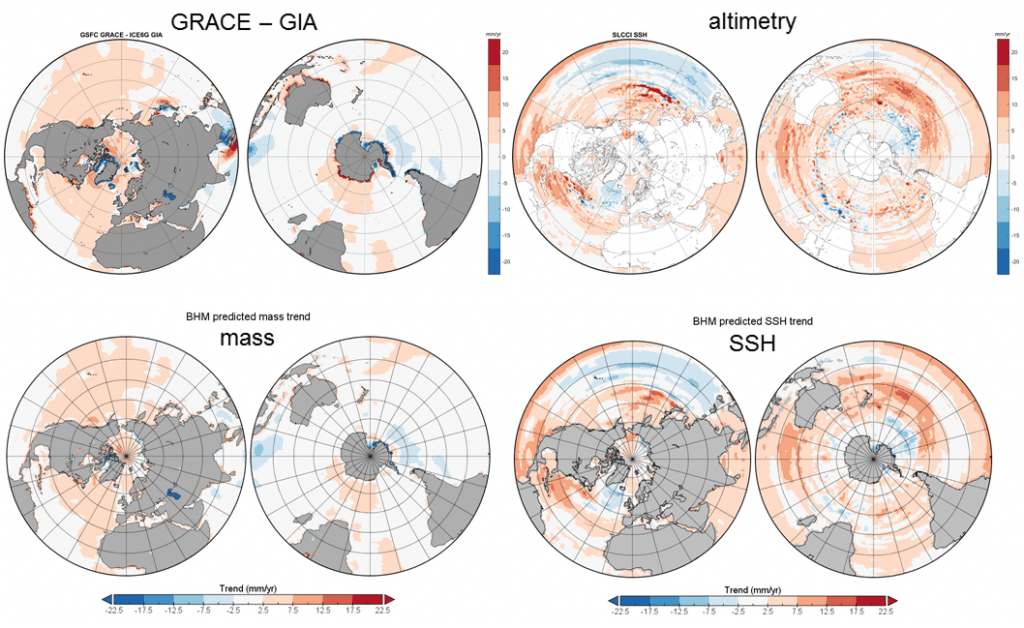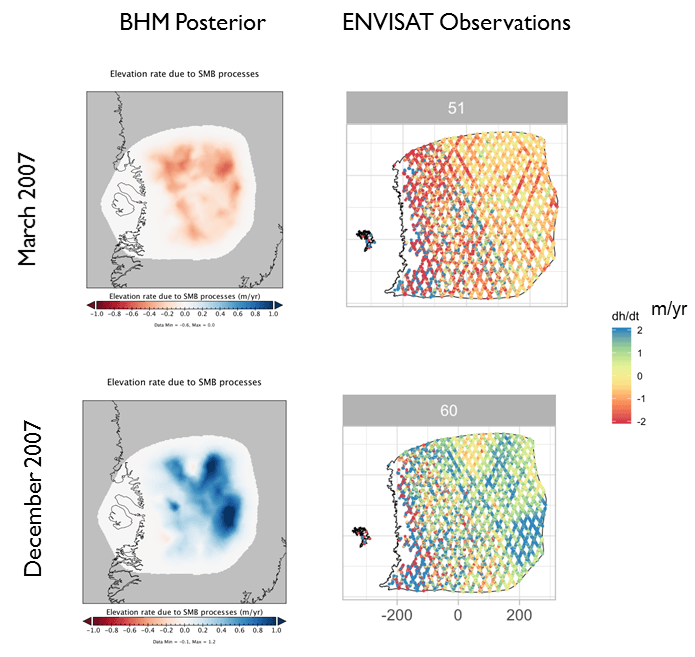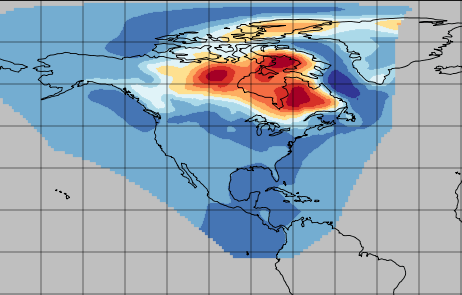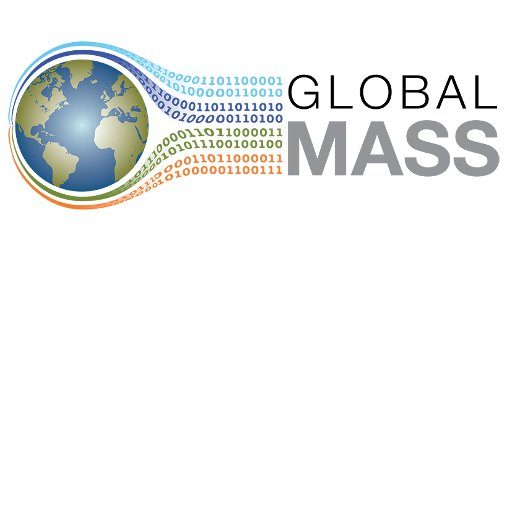It’s been over six months since our last update, during which time we have been steadily making progress in several aspects of the project:
(1) Steric sea level change
We have previously reported that an estimation of a steric sea level change signal (i.e. sea level change due to variations in water density, primarily thermal expansion) would be the first real test of the BHM framework on a global scale. Several iterations later and we are still analysing whether the results tell us more about large-scale steric trends or the quality and reliability of the observational data used…
Since the initial results, we have tested and improved various aspects of the experimental set-up including:
-
which version of the Gravity Recovery and Climate Experiment (GRACE) data we use;
-
how non-stationery processes (those that do not tend towards a constant long-term average or spread through time) are represented; and
-
how we correct for glacial isostatic adjustment (GIA).
Exploring these aspects has shown us that the Bayesian Hierarchical Framework (BHM) is operating as it should and increased our confidence in the steric results it produces (Figure 1) and, as a global average, our steric results are now close to observational estimates (from Argo floats).

Figure 1. Comparison of observed (top) and BHM-predicted (bottom) trend in ocean mass (left) and sea surface height (right) for the period 2005-2015. For each pair of plots, the trend value is given in the left-hand map and the trend error in the right-hand map.
However, significant discrepancies continue to occur at a regional to local scales. As we are confident that the BHM is replicating observations, the implication is that signals at these scales are not well represented in the observational datasets (GRACE, Argo and/or altimetry). Deeper analysis of the different observational datasets has thus become an ongoing focus.
(2) Investigating Greenland mass balance using a BHM approach
We reported on our first mass trend results for Greenland using a BHM approach earlier in the year but highlighted that the BHM was not allocating the total change correctly between the two main contributory processes, ice dynamics and surface mass balance.
This led us to re-think about how best to implement the BHM for Greenland, and ultimately to change from an annual to a monthly timestep. Since the surface mass balance has a strong seasonal cycle in Greenland (summer melt and winter accumulation), this provides us with a more reliable way of separating it from the ice dynamic signal, which in general is less influenced by seasonal variations. It did, however, require a considerable amount of effort rewriting model code and reprocessing datasets. We were grateful to welcome project partner Dr Andrew Zammit-Mangion from University of Wollongong, Australia, to Bristol for a month during the autumn, who provided help with the implementation of the monthly timestep.
The new monthly set-up is being tested initially for a single basin, Jakobshaven Isbrae, and for a single year, 2007. Early results are encouraging (Figure 2), and we hope to scale it up to the entire Greenland ice sheet for a longer time period in the coming months.

Figure 2. Predicted change in ice elevation due to surface mass balance (SMB) processes from the BHM (BHM posterior) compared to observed ice elevation change from the ENVISAT satellite for two months (March 2007 and December 2007).
(3) GIA and mass change for North America
A new area of investigation for us has been to develop the BHM framework to explore vertical land motion (VLM) for North America, with the aim of separating the signal into its GIA and mass change components. This will be the first time that we have assimilated GRACE and GPS data simultaneously, which should allow us to ‘solve for’ (i.e. create BHM-predictions of) GIA and mass change. North America has been selected as it is well observed, the geophysical processes are relatively well understood and we are able to build on and test previous work by Simon et al (2017) [1].
Early results from this work are encouraging, and our BHM-predicted GIA trend (Figure 3) shows a similar magnitude and pattern to that reported by Simon et al. Future work is planned to further improve the GPS data, as well as investigate whether the elastic response to mass changes is an important signal that we should also be including.

Figure 3. BHM-predicted GIA trend for 2005-2015 for North America
(4) The potential contribution of ice sheets to future sea level rise
Although not a central part of the GlobalMass project, in early 2018 we helped organise a structured expert judgement (SEJ) exercise to explore the current uncertainties in ice sheet contributions to sea level rise. The potential contribution of the ice sheets remains the largest uncertainty in projecting sea level rise beyond 2050 due to limitations in the predictive capability of numerical modelling approaches. SEJ represents an alternative approach which provides a formal approach for estimating uncertain quantities based on current scientific understanding. Two workshops were conducted to elicit estimated future ice sheet contributions for four time periods (2050, 2100, 2200, 2300) and two temperature scenarios for the Greenland, West Antarctic and East Antarctic ice sheets. A paper that provides full details of the approach and the results obtained is currently in review.
New publications
Schumacher M, King MA, Rougier J, Sha Z, Khan SA and Bamber JL (2018) A new global GPS data set for testing and improving modelled GIA uplift rates, Geophysical Journal International 214(3), 2164-2176 (DOI: 10.1093/gji/ggy235 ![]() ).
).
WCRP Global Sea Level Budget Group (2018) including Bamber JL, Chuter S and Westaway RM. Global sea-level budget 1993–present, Earth Syst. Sci. Data, 10, 1551-1590 (DOI: 10.5194/essd-10-1551-2018 ![]() ).
).
Sha, Z, Rougier, J, Schumacher, M, and Bamber, JL (2018). Bayesian model–data synthesis with an application to global glacio-isostatic adjustment. Environmetrics e2530. (DOI: 10.1002/env.2530).
Other outputs
Chuter S (2018). Antarctica: A decade of dynamic change. ‘Image of the Week’ on the EGU Cryosphere Division blog, May 2018.
Bamber JL (2018). Land ice contribution to SLR from 1992-present. Oral presentation at POLAR 2018, Davos, Switzerland, 15-26 June 2018.
Bamber JL (2018). A novel global GPS data set for GIA modelling and validation. Oral presentation at POLAR 2018, Davos, Switzerland, 15-26 June 2018.
Sha, Z, Rougier J, Schumacher M and Bamber JL (2018). Bayesian model-data synthesis with an application to global Glacio-isostatic adjustment. Poster at IBSA 2018 World Meeting, Edinburgh, 24-29 June 2018.
Royston S (2018). Steric sea-level trends in the Argo epoch: First results from an integrated, spatial sea-level budget assessment. Oral presentation at Sea Level Futures Conference, Liverpool 2–4 July 2018.
Bamber JL (2018). The land ice contribution to sea level during the satellite era. Oral presentation at Sea Level Futures Conference, Liverpool 2–4 July 2018.
Vishwakarma BD, Royston S, Chuter S, Sha Z, Westaway RM, Rougier J and Bamber JL (2018). GlobalMass: a Bayesian modelling approach for closing the sea-level budget. Poster at GRACE/GRACE-FO Science Team Meeting 2018, Potsdam, Germany, 9-11 October 2018.
References
[1] Simon, K. M., Riva, R. E. M., Kleinherenbrink, M., & Tangdamrongsub, N. (2017). A data-driven model for constraint of present-day glacial isostatic adjustment in North America. Earth and Planetary Science Letters, 474, 322-333 [DOI:10.1016/j.epsl.2017.06.046]

